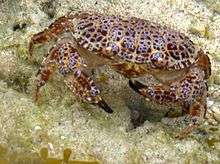Zosimus aeneus
Zosimus aeneus is a species of crab that lives on coral reefs in the Indo-Pacific from East Africa to Hawaii. It grows to a size of 60 mm × 90 mm (2.4 in × 3.5 in) and has distinctive patterns of brownish blotches on a paler background. It is potentially lethal due to the presence in its flesh and shell of the neurotoxins tetrodotoxin and saxitoxin.
| Zosimus aeneus | |
|---|---|
 | |
| Zosimus aeneus at Atauro | |
| Scientific classification | |
| Kingdom: | Animalia |
| Phylum: | Arthropoda |
| Subphylum: | Crustacea |
| Class: | Malacostraca |
| Order: | Decapoda |
| Infraorder: | Brachyura |
| Family: | Xanthidae |
| Subfamily: | Zosiminae |
| Genus: | Zosimus |
| Species: | Z. aeneus |
| Binomial name | |
| Zosimus aeneus | |
| Synonyms [1] | |
| |
Description
Zosimus aeneus reaches a size of 60 by 90 millimetres (2.4 in × 3.5 in).[2] It is "a well known brightly coloured and strikingly patterned species":[3] its carapace and legs (including the claws) are marked with a characteristic pattern of red or brown patches on a pale brown or cream background. The carapace is deeply grooved, and the walking legs have prominent crests.[4]
Distribution and ecology
Zosimus aeneus is found across a large part of the Indo-Pacific, from South Africa to the Red Sea, and as far east as Japan, Australia and Hawaii.[2] It lives on reef flats in the intertidal zone.[2][4]
Taxonomy
Zosimus aeneus was first described by Carl Linnaeus in his 1758 10th edition of Systema Naturae. It was transferred to the genus "Zozymus" by James Dwight Dana in 1852, which was replaced with Zosimus by Mary J. Rathbun in 1907.[2] It is the type species of the genus Zosimus.[2]
Toxicity
Both the shell and the meat of Zosimus aeneus contain significant concentrations of neurotoxins including tetrodotoxin and saxitoxin.[5] Tetrodotoxin (TTX) is the compound responsible for the toxicity of puffer fish, while saxitoxin (SXN) is the best known of several related neurotoxins that cause paralytic shellfish poisoning (PSP).[6] Both are absorbed through the gastrointestinal tract and interfere with sodium channels in the membranes of nerve cells.[6] Poisoning with Z. aeneus can be fatal; one man in Timor-Leste died hours after consuming the crab, having received a dose equivalent to 1–2 μg saxitoxin per kilogram body mass.[7] The flesh of Z. aeneus is reported to be ingested by inhabitants of the Pacific Islands with the intention of committing suicide.[8]
References
- Peter Davie (2010). "Zosimus aeneus". World Register of Marine Species. Retrieved March 2, 2011.
- Raoul Serène & Alain Crosnier (1984). "Sous-famille des Zosiminae Alcock, 1898". Crustacés Décapodes Brachyoures de l'Océan Indien Occidental et de la Mer Rouge. Xanthoidea: Xanthidae et Trapeziidae [Crabs (Crustacea: Decapoda: Brachyura) of the Western Indian Ocean and Red Sea. Xanthoidea: Xanthidae and Trapeziidae]. Volume 24 of Faune Tropicale (in French). ORSTOM. pp. 137–172. ISBN 978-2-7099-0701-9.
- Peter K. L. Ng; Danièle Guinot; Peter J. F. Davie (2008). "Systema Brachyurorum: Part I. An annotated checklist of extant Brachyuran crabs of the world" (PDF). Raffles Bulletin of Zoology. 17: 1–286.
- Gerald Allen (2000). "Crustaceans. One of the reef's most dominant groups". Marine Life of the Pacific and Indian Oceans. Periplus Nature Guides. Tuttle Publishing. pp. 31–40. ISBN 978-962-593-948-3.
- D. S. Bhakuni & Diwan S. Rawat (2005). "Bioactive metabolites of marine invertebrates". Bioactive Marine Natural Products. Gulf Professional Publishing. pp. 26–63. ISBN 978-1-4020-3472-5.
- Patrick Williams; Scott Willens; Jamie Anderson; Michael Adler & Corey J. Hilmas (2009). "Toxins: established and emergent threats". In Shirley D. Tuorinsky (ed.). Medical Aspects of Chemical Warfare. Government Printing Office. pp. 613–644.
- Hans P. Egmond; M. E. van Apeldoorn & G. J. A. Speijers (2004). "Paralytic Shellfish Poisoning (PSP)". Marine Biotoxins. FAO Food and Nutrition Paper 80. Food and Agriculture Organization of the United Nations. pp. 5–52. ISBN 978-92-5-105129-0.
- "Creature Feature – Toxic Crabs". Western Australian Museum. Retrieved 23 January 2017.
External links
- Photos of Zosimus aeneus on Sealife Collection